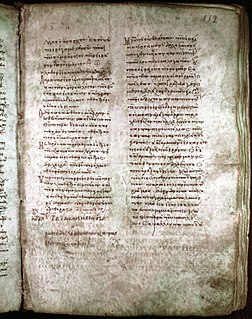Related Research Articles

New Testament manuscripts in Greek are categorized into five groups, according to a scheme introduced in 1981 by Kurt and Barbara Aland in The text of the New Testament. The categories are based on how each manuscript relates to the various text-types. Generally speaking, earlier Alexandrian manuscripts are category I, while later Byzantine manuscripts are category V. Aland's method involved considering 1000 passages where the Byzantine text differs from non-Byzantine text. The Alands did not select their 1000 readings from all of the NT books; for example, none were drawn from Matthew and Luke.

Uncial 053 (in the Gregory-Aland numbering), A4 (Soden), is a Greek uncial manuscript of the New Testament, dated paleographically to the 9th century.

Minuscule 1143, ε 1035, also known as the Beratinus 2, or Codex Aureus Anthimi. It is a Greek minuscule manuscript of the New Testament on purple parchment, dated paleographically to the 9th century. This is one of the seven “purple codices” in the world to have survived to the present day, and one of the two known purple minuscules written with a gold ink.

Uncial 0209, is a Greek uncial manuscript of the New Testament, dated palaeographically to the 7th-century.
Uncial 0233, is a Greek uncial manuscript of the New Testament. The manuscript paleographically had been assigned to the 8th-century.
Minuscule 2423, is a Greek minuscule manuscript of the New Testament, on 227 parchment leaves ; it is dated paleographically to the 13th century.
Minuscule 2612, is a Greek minuscule manuscript of the New Testament, on 184 parchment leaves. Dated paleographically to the 13th century.
Minuscule 2613, is a Greek minuscule manuscript of the New Testament, on parchment. Dated paleographically to the 11th century.

Minuscule 2614, is a Greek minuscule manuscript of the New Testament, dated paleographically to the 13th century.
Minuscule 2615, is a Greek minuscule manuscript of the New Testament, written on paper and parchment in a form of scroll.
Minuscule 2268, ε 2058, is a Greek minuscule manuscript of the New Testament. Paleographically it has been assigned to the 13th century. Only one leaf of the codex has survived.
Minuscule 2616, is a Greek minuscule manuscript of the New Testament, written on 280 parchment leaves. Paleographically it has been assigned to the 12th century.
Minuscule 2757, is a Greek minuscule manuscript of the New Testament, written on 266 parchment leaves. Palaeographically it has been assigned to the 12th century.
Minuscule 1780 δ 412, is a Greek minuscule manuscript of the New Testament, written on 198 parchment leaves. Paleografically it has been assigned to the 13th century.
Minuscule 2491, is a Greek minuscule manuscript of the New Testament, on 61 parchment leaves. It is dated paleographically to the 12th century. The text is written in one column per page, in 24 lines per page.

Minuscule 1424, δ 30 is a Greek minuscule manuscript of the New Testament, written on 337 parchment leaves. It has been dated paleographically to the 9th or 10th century).
Codex Daltonianus, known as Minuscule 1423 (in the Gregory-Aland numbering), designated by A119 (in the Soden numbering), is a Greek minuscule manuscript of the New Testament, written on a paper. Palaeographically it had been assigned to the 14th century (or about 1200).
Minuscule 1813, designated by number 1813, ε 3047 (Soden), is a Greek minuscule manuscript of the New Testament, written on 235 parchment leaves. Paleografically it had been assigned to the 11th century.
Minuscule 827, ε309, is a 13th-century Greek minuscule manuscript of the New Testament on parchment.
Minuscule 1356, ε1087, is an 11th-century Greek minuscule manuscript of the New Testament on parchment. The manuscript has complex contents.
References
- 1 2 K. Aland, M. Welte, B. Köster, K. Junack, Kurzgefasste Liste der griechischen Handschriften des Neues Testaments, Walter de Gruyter, Berlin, New York 1994, p. 208.
- ↑ Minuscule 2766 at the Kenneth Willis Clark Collection of Greek Manuscripts
- ↑ Aland, Kurt; Aland, Barbara (1995). The Text of the New Testament: An Introduction to the Critical Editions and to the Theory and Practice of Modern Textual Criticism. Erroll F. Rhodes (trans.). Grand Rapids: William B. Eerdmans Publishing Company. p. 140. ISBN 978-0-8028-4098-1.
- ↑ Wisse, Frederik (1982). The Profile Method for the Classification and Evaluation of Manuscript Evidence, as Applied to the Continuous Greek Text of the Gospel of Luke . Grand Rapids: William B. Eerdmans Publishing Company. p. 90. ISBN 0-8028-1918-4.